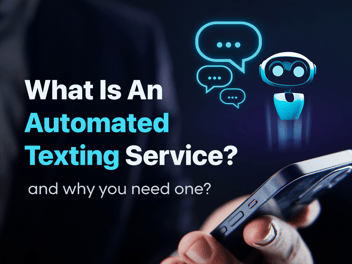What is AI Texting?

AI Texting, also known as AI-generated text or artificial intelligence texting, is a revolutionary technology that leverages the power of language models and natural language processing to generate high-quality text content. It serves as a writing assistant, helping individuals and businesses create various types of written content, including product descriptions, blog posts, social media posts, and even SMS messages.
What sets AI Texting apart is its ability to mimic human language and produce responses that resemble those of real people. Through sophisticated algorithms and machine learning, AI Texting can understand and analyze human input, generating human-like responses that are indistinguishable from texts written by humans.
This cutting-edge technology is not without its privacy concerns. With the ability to generate content that imitates human writing, there is always the risk of harmful or inappropriate content being produced. However, responsible AI Texting platforms and software providers employ rigorous safety measures to ensure the quality and safety of the generated text. They also constantly update their models to minimize the risk of unsafe content creation.
AI Texting is a valuable tool for content creators and businesses alike. It allows content creators to generate fresh and creative content ideas, saving them time and providing a valuable resource for content creation. For businesses, AI Texting can assist in crafting compelling marketing campaigns, writing persuasive sales copy, and even providing lists to enhance marketing strategies.
Using AI Texting offers numerous advantages, including faster writing processes, access to writing templates and prompts, and the ability to scale content creation efforts. With AI-generated text, businesses can streamline their messaging and communicate with their audience more efficiently.
The impact of AI Texting is significant. It has been shown to improve contact rates, increase engagement rates (typically ranging from 2-5%), and ultimately result in higher enrolment rates or increased application rates for businesses. With limited time for projects and limited time with sales representatives, AI Texting can help businesses accelerate their turnaround time and communicate effectively using modern messaging features.
In conclusion, AI Texting is an innovative technology that harnesses the power of artificial intelligence to generate human-like language. It offers a wide range of applications, from content creation to marketing campaigns, and provides valuable support to content creators and businesses alike. While privacy concerns remain important, the benefits and potential of AI Texting are undeniable.
Benefits of AI Texting
AI Texting offers a wide range of benefits for content creators, businesses, and organizations. With its advanced language model and natural language processing capabilities, AI Texting revolutionizes the way we communicate and interact with written content. Here are some key advantages of AI Texting:
- Faster Writing Process: One of the most significant advantages of AI Texting is its ability to expedite the writing process. With AI-generated text, content creators can save valuable time on crafting engaging and informative pieces. AI Texting platforms provide users with a vast library of writing templates and prompts, enabling them to generate content quickly and efficiently.
- Improved Content Ideas: AI Texting is an invaluable resource for generating fresh and creative content ideas. Content creators can use AI-generated text to brainstorm content for blogs, social media posts, product descriptions, and more. This helps them stay inspired and continually produce captivating and relevant pieces for their target audience.
- Enhanced Marketing Strategies: AI Texting can significantly enhance marketing campaigns and strategies. By leveraging AI-generated text, businesses can craft persuasive sales copy, create engaging marketing materials, and develop effective email marketing campaigns. With its ability to mimic human language, AI Texting helps businesses connect with their audience on a more personal level, ultimately increasing customer engagement and conversion rates.
- Streamlined Messaging: AI Texting allows businesses to streamline their messaging and communication efforts. With instant messaging platforms becoming increasingly popular, AI Texting can generate human-like responses for quick and efficient interactions. This enables businesses to maintain a high level of customer support and engagement, saving time for both the business and its customers.
- Increased Enrollment and Application Rates: The impact of AI Texting on business outcomes cannot be understated. Studies have shown that implementing AI Texting can improve contact rates, increase engagement rates (typically ranging from 2-5%), and ultimately result in higher enrollment or application rates for businesses. With limited time for projects and interactions with sales representatives, AI Texting can help businesses accelerate their turnaround time and communicate effectively using modern messaging features.
In conclusion, AI Texting offers a multitude of benefits for content creators and businesses. From faster writing processes and improved content ideas to enhanced marketing strategies and increased enrolment rates, AI Texting empowers organizations to communicate more efficiently, connect with their target audience on a deeper level, and achieve their business goals with greater success. By leveraging the power of AI-generated text, businesses can unlock a world of new possibilities and stay ahead in today's competitive landscape.
Challenges of AI Texting
As with any new technology, AI Texting also comes with its own set of challenges. While AI Texting has many benefits, there are some potential obstacles that need to be addressed. Here are a few challenges that businesses and content creators may face when using AI Texting:
- Privacy Concerns: One of the biggest challenges associated with AI Texting is the concern over privacy. AI Texting platforms often require access to personal data and user information to generate human-like responses. This raises concerns about the security and privacy of sensitive information. Businesses need to ensure proper data protection and implement measures to address these concerns.
- Ensuring Authenticity: AI Texting platforms strive to generate content that mimics human language. However, there is always the risk of the text not sounding genuine or authentic. Content creators need to carefully review and edit the AI-generated text to ensure that it aligns with their brand voice and maintains a personal touch.
- Filtering Harmful and Inappropriate Content: AI Texting relies on machine learning algorithms to generate text, which means there is a possibility of inappropriate or harmful content being produced. Content creators need to implement strict filters and constantly monit
- Trust and Credibility: As AI Texting becomes more prevalent, there is a concern about whether the content is truly written by humans or if it is AI-generated. This can lead to doubts about the authenticity and credibility of the content. Content creators need to be transparent about the use of AI Texting and clearly indicate when text has been generated by AI to maintain trust with their audience.
- Limitations in Complex Texts: While AI Texting is great for generating short-form text such as social media posts or product descriptions, it may struggle with more complex content. AI may not be able to provide the same level of depth and analysis as a human writer when it comes to writing longer articles, research papers, or in-depth blog posts. Content creators need to understand the limitations of AI Texting and ensure that it is used appropriately for various content types.
Despite these challenges, AI Texting has the potential to revolutionize the way businesses connect with their audience and streamline their communication efforts. By addressing these concerns and implementing proper measures, businesses can leverage AI Texting to enhance their content creation process and improve customer engagement.
Language Model for AI Texting
Language Model: Enhancing AI Texting for More Natural and Engaging Conversations
In the realm of AI Texting, language models play a crucial role in enabling machines to understand and generate human-like responses. Language modeling is a branch of natural language processing (NLP) that focuses on improving the accuracy and fluency of text generated by AI.
A language model is essentially a statistical model trained on vast amounts of human language data. It learns the patterns, syntax, and semantic nuances of human communication and uses this knowledge to generate coherent and contextually relevant text. By understanding the structure and flow of human language, language models provide AI texting platforms with the ability to generate responses that are indistinguishable from those of a real person.
The use of language models in AI texting has revolutionized the way businesses communicate and engage with their customers. Whether it's crafting product descriptions, writing blog posts, or even composing social media updates, language models enable content creators to save time and effort by automating the writing process.
One of the key advantages of language models is their ability to produce content that aligns with the brand voice and maintains a personal touch. By fine-tuning these models, content creators can ensure that the AI-generated text reflects the organization's unique tone and style. This helps in creating an authentic and engaging experience for the audience, fostering stronger connections and driving higher engagement rates.
However, as with any AI-powered technology, there are certain considerations when using language models for AI texting. Privacy concerns are at the forefront, as language models often require access to personal data and user information to generate accurate responses. Businesses need to prioritize data protection and implement robust security measures to address these concerns and safeguard sensitive information.
Another challenge is the potential for harmful or inappropriate content to be generated by language models. While language models strive to mimic human language, there is always a risk of generating unsafe or offensive text. Content creators must carefully monitor and filter the AI-generated text to ensure that it meets ethical and regulatory standards.
Furthermore, there is a need for transparency and clear communication with the audience regarding the use of language models. Trust and credibility are paramount, and it is essential to disclose when AI-generated text is being utilized. By being transparent, businesses can maintain the trust of their audience and avoid any misinterpretation or doubt about the authenticity of the content.
Lastly, it is important to acknowledge that while language models excel at producing short-form content like social media posts or product descriptions, they may have limitations when it comes to more complex texts. AI may struggle with providing the same level of analysis and depth as a human writer in areas such as research papers, in-depth blog posts, or lengthy articles. Content creators should understand these limitations and apply language models accordingly, ensuring that they are used appropriately for different content types.
In conclusion, language models are a powerful tool for enhancing AI texting platforms. With their ability to generate human-like responses and save time in content creation, they have become invaluable in modern marketing strategies. However, businesses must address privacy concerns, filter harmful content, maintain trust and transparency, and understand the limitations of language models to harness their full potential and deliver engaging and authentic conversations.
Natural Language Processing
Natural Language Processing (NLP) is a field of study that focuses on the interaction between computers and human language. It involves the development of algorithms and models that allow machines to understand, interpret, and generate human language in a way that is similar to how humans do.
At its core, NLP utilizes a combination of computer science, artificial intelligence, and linguistics to process and analyze unstructured data, which is the natural form of human language. Whether it's written text, spoken words, or even sign language, NLP aims to bridge the gap between human communication and machine understanding.
One of the fundamental tasks of NLP is called sentiment analysis. Sentiment analysis involves the classification of text into positive, negative, or neutral sentiments. By analyzing the tone and context of a piece of text, NLP algorithms can determine the underlying emotions and opinions expressed. This can be immensely valuable for businesses looking to gain insights into customer feedback or for social media platforms monitoring user sentiment.
Another important area of NLP is information extraction. Information extraction involves extracting structured data and relevant information from unstructured text. This can include extracting names, dates, locations, or any specific details mentioned in a document. NLP algorithms can automatically identify and extract this information, saving time and effort for businesses and researchers.
Machine translation is another notable application of NLP. With the growing need for global communication, NLP algorithms have made significant advancements in the field of automatic translation. Machine translation algorithms can now translate text from one language to another with reasonable accuracy, allowing people from different linguistic backgrounds to communicate and understand each other more easily.
NLP also plays a crucial role in virtual assistants and chatbots. Virtual assistants like Siri, Alexa, or Google Assistant rely heavily on NLP algorithms to listen, understand, and respond to user queries. NLP enables these virtual assistants to recognize speech patterns, understand their intents, and provide appropriate responses in a natural and human-like manner.
However, NLP still faces challenges. Human language is complex and diverse, with many variations, idioms, and nuances. NLP algorithms need to account for these complexities to accurately interpret and generate language. Additionally, challenges like ambiguity, context, and sarcasm pose further obstacles in achieving perfect language understanding and generation.
Despite these challenges, NLP continues to evolve, with advancements in deep learning techniques, neural networks, and language models. These advancements have led to significant improvements in machine translation, sentiment analysis, and information extraction. NLP is a rapidly expanding field that has the potential to revolutionize how we communicate, interact with machines, and process vast amounts of textual data.
In conclusion, Natural Language Processing is a vibrant and dynamic field that seeks to bridge the gap between human language and machine understanding. Its applications are diverse, ranging from sentiment analysis and machine translation to virtual assistants and chatbots. As NLP technology continues to advance, we can expect even more exciting developments in the realm of human-computer interaction and language processing.
Writing Assistant
A writing assistant is an invaluable tool for anyone who writes, whether it be professional content creators, students, or even casual bloggers. With the rise of technology and artificial intelligence, writing assistance has become more accessible and advanced than ever before.
A writing assistant is essentially an AI-powered tool that helps users improve their writing skills and generate high-quality content. It utilizes Natural Language Processing (NLP) algorithms to analyze and understand text, offering suggestions, corrections, and insights to enhance the overall writing experience.
One of the primary features of a writing assistant is its ability to provide grammar and spelling corrections. It can instantly detect errors and offer suggestions for improvement, ensuring that your writing is polished and error-free. This saves time and effort by eliminating the need for tedious proofreading.
In addition to grammar and spelling, a writing assistant can also help with language style and tone. It can suggest alternative words or phrases to enhance clarity, conciseness, and overall impact. Whether you're writing a professional email, a blog post, or a social media caption, a writing assistant can provide valuable insights to make your content more engaging and effective.
Another notable feature of a writing assistant is its ability to provide content ideas and suggestions. It can analyze existing text and generate relevant and creative content ideas based on keywords or topics. This is particularly beneficial for content creators, as it can provide inspiration and streamline the brainstorming process.
Furthermore, a writing assistant can offer assistance with structuring and organizing your writing. It can provide suggestions on paragraph breaks, headings, and overall flow, ensuring that your content is well-structured and easy to read. This is especially useful for longer pieces such as essays or reports.
Privacy concerns are often raised when it comes to AI-powered writing assistants. However, reputable writing assistant tools prioritize user privacy and data security. They employ encryption protocols and adhere to strict privacy policies to safeguard user information.
While a writing assistant can greatly enhance the writing process, it's important to remember that it's still a tool. It doesn't replace the need for human creativity and critical thinking. It simply provides guidance and support to help users write more effectively.
In conclusion, a writing assistant is an invaluable tool for anyone looking to improve their writing skills, be it for professional or personal purposes. With its ability to provide grammar corrections, content ideas, and structural suggestions, a writing assistant can greatly enhance the overall writing experience. However, it's essential to acknowledge that human creativity and critical thinking still play a vital role in producing exceptional content. So, embrace the power of AI-powered writing assistance, but remember to infuse it with your unique voice and perspective.
Product Descriptions
Product descriptions are a crucial aspect of any e-commerce business. They serve as the bridge between the product itself and the potential customer, providing key details and enticing consumers to make a purchase. However, writing compelling product descriptions can be a challenging task.
This is where a writing assistant comes in handy. With its advanced language model and natural language processing capabilities, a writing assistant can help you craft engaging and persuasive product descriptions that effectively communicate the value and benefits of your products.
One of the key advantages of using a writing assistant for product descriptions is its ability to generate human-like responses. It can analyze the key features and specifications of your product and suggest suitable language that resonates with your target audience. By using the right words and tone, a well-crafted product description can captivate customers and compel them to buy.
Additionally, a writing assistant can ensure that your product descriptions are clear, concise, and free of errors. It can help you eliminate any grammar or spelling mistakes, resulting in professional and polished descriptions. This attention to detail enhances the credibility of your brand and instills confidence in customers.
Moreover, a writing assistant can assist with creating unique and original product descriptions. With the vast amount of online content available, it's crucial to stand out from the competition. A writing assistant can provide content ideas and writing prompts to help you craft product descriptions that are creative and engaging, setting your brand apart from others in the market.
Using a writing assistant for product descriptions can also help streamline your writing process. It provides writing templates and suggestions for different types of products, making it easier and faster to create accurate and compelling descriptions. This saves you valuable time and allows you to focus on other aspects of your business.
However, while a writing assistant can greatly aid in the creation of product descriptions, it's important to use it as a tool and not rely solely on its suggestions. Ultimately, no one knows your product better than you do. Combine your expertise with the assistance of a writing assistant to create product descriptions that effectively communicate the unique selling points and benefits of your offerings.
In conclusion, a writing assistant is an invaluable tool for crafting persuasive and enticing product descriptions. It not only enhances the writing process but also ensures that your descriptions are error-free and captivating. Embrace AI-powered technology to elevate your product descriptions and attract more customers to your e-commerce store.
Human-Like Responses from AI Texting
AI texting has come a long way in recent years, and one of the most impressive advancements is its ability to generate human-like responses. Gone are the days of robotic and stiff interactions with automated systems. Now, AI models can understand and respond to text messages in a way that mimics human conversation.
This breakthrough is thanks to the advancements in natural language processing (NLP) technology. AI-powered chatbots and messaging platforms can now analyze the context, tone, and intent behind text messages, allowing them to generate responses that feel like they're coming from a real person.
The benefits of human-like responses in AI texting are numerous. Firstly, it creates a more engaging and personal experience for users. Instead of feeling like they're interacting with a machine, customers will feel like they're talking to a knowledgeable and helpful human agent. This can help foster trust and build stronger relationships with customers.
Human-like responses also contribute to better communication. It enables chatbots and virtual assistants to understand and interpret different linguistic nuances, sarcasm, and even emojis. This means that customers can communicate naturally, without needing to simplify their language or use specific keywords. They can simply type in their questions or concerns, and the AI system will understand and respond appropriately.
Another advantage of human-like responses is the ability to provide tailored and relevant information. AI models can analyze the content of text messages and generate personalized responses based on the specific needs and preferences of the user. This level of personalization enhances the overall user experience and increases customer satisfaction.
However, it's essential to address privacy concerns when it comes to AI-generated text. While AI systems have become adept at mimicking human language, it's crucial to remember that they are still machines. Allowing AI systems to generate responses in real-time requires access to vast amounts of data, which raises valid privacy concerns. It's important for businesses to ensure that they are transparent about how customer data is stored and used to generate responses.
In conclusion, human-like responses from AI texting have revolutionized the way businesses communicate with their customers. With the advancements in NLP technology, chatbots and virtual assistants now have the ability to understand and respond to text messages in a way that feels natural and human-like. This enhanced communication improves the user experience, builds trust, and allows for personalized interactions. However, it's important to strike a balance between the benefits of human-like responses and the need to address privacy concerns.
Real People vs. Automated Messages
When it comes to customer service and communication, there has always been a debate about whether real people or automated messages are more effective. With the rise of AI-powered chatbots and messaging platforms, this debate has become more relevant than ever.
Real people bring a human touch to customer interactions. They can empathize, understand complex issues, and provide personalized solutions. Customers appreciate the ability to speak to a live person who can immediately address their concerns and provide real-time support. Real people can adapt to various situations and provide nuanced responses that take into account the customer's emotions and unique circumstances.
On the other hand, automated messages offer efficiency and scalability. They can handle a high volume of inquiries simultaneously, ensuring that no customer is left waiting for a response. Automated messages can also provide consistent information and follow predefined rules, reducing the risk of human error. They are available 24/7, ensuring that customers can get assistance even outside of business hours.
The advancements in AI technology have made automated messages more sophisticated, with natural language processing (NLP) enabling chatbots to generate responses that feel human-like. These chatbots can analyze the context and intent behind text messages, enabling them to understand and respond appropriately. They can even learn from previous interactions to improve the quality of their responses over time.
However, there are still limitations to automated messages. While they can handle common inquiries and provide basic information, they may struggle with more complex issues that require human judgment and critical thinking. Automated messages can sometimes feel impersonal and detached, lacking the human touch that real people bring to conversations.
The ideal solution lies in striking a balance between real people and automated messages. Businesses can leverage the efficiency and scalability of automated messages for routine inquiries and frequently asked questions. This ensures that customers get quick and accurate responses without overwhelming the support staff.
For more complex issues or situations that require emotional support, real people should be readily available. The ability to speak to a live person who can understand and empathize with the customer's situation can make a significant difference in customer satisfaction and loyalty.
In summary, there is no one-size-fits-all answer to the real people vs. automated messages debate. Both have their advantages and limitations. The key is to find the right balance and leverage technology to enhance customer service while still providing the human touch when needed. By adopting a hybrid approach, businesses can offer a seamless and personalized customer experience that meets the needs and expectations of today's consumers.
A programmer by trade, Nick Saraev is a freelance writer and entrepreneur with a penchant for helping people achieve their business goals. He's been featured on Popular Mechanics & and Apple News and has founded several successful companies in e-commerce, marketing, and artificial intelligence. When he's not working on his latest project, you can find him hiking or painting.


.png?width=512&height=512&name=guru%20(1).png)

.png?width=199&height=109&name=salesforce-logo1-removebg-preview%20(1).png)


.webp?width=716&height=569&name=banner-img%20(1).webp)



